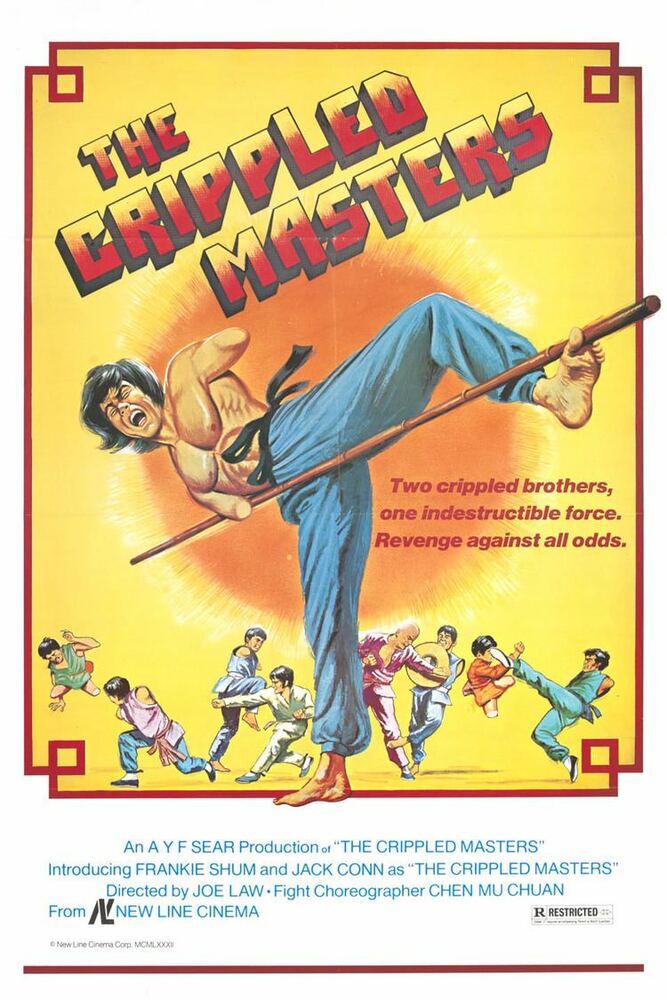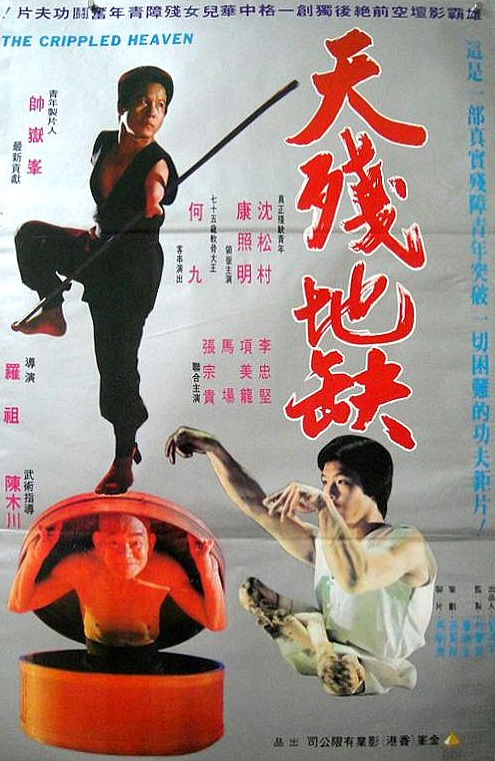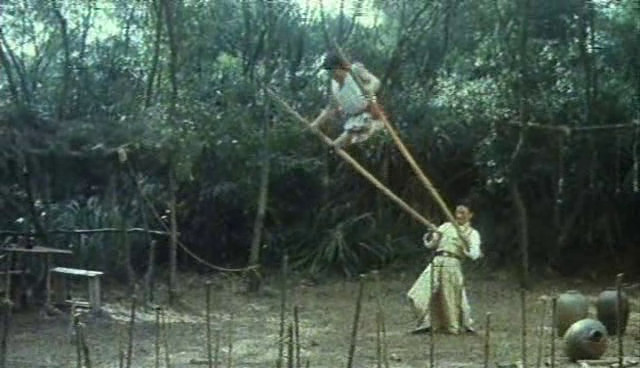Director: Chi Lo (Joe Law)
Writer: Unknown
Stars: Li Chung Keng, Chen Mu Chuan, Frank Shum, Jack Con and Ho Chiu
  |
Index: Weird Wednesdays.
Every now and then, I see mention of Blazing Saddles, the groundbreaking 1974 Mel Brooks comedy, and, wherever that mention is, it’s usually accompanied by two opinions: firstly, it’s still incredibly funny, and, secondly, nobody could remake it today. Now, they may have a point about that (even though they just did, as Paws of Fury), but The Crippled Masters never fails to spring immediately to mind as an equivalent. Even though it has an easy reading as a film that enables the disabled, it’s so outrageous in the way in which it does so that many would find it difficult to watch and I can’t imagine that anyone could tread this ground in 2020. I adore it and, even though it’s a truly awful film in many quantifiable ways, I think I always will, however many times I watch it. The basic idea is to cast a martial arts movie with cripples, a word I only use here because it’s the word used throughout the English dub of the film to describe the characters at its heart. That’s not just Lee Ho and Tang, the two crippled masters of the title, but presumably their nemesis, Lin Chang Cao, as well.
It’s Lee Ho we see first, losing his arms in a judgement by his boss. No, I’m not talking about heraldry, I’m talking about the severing of his upper limbs with a sword. Fewer than ten seconds after the opening credits wrap, we hear a scream and watch an arm fall to the Pluahchi crime organisation’s courtyard floor and, fifteen seconds later, his other arm joins it. We don’t actually see the act and the fake arms are props, but it appears shockingly real. This is a Hong Kong movie shot in Taiwan in 1979, after all. Do you think the production had a CGI budget? This is surely why there’s surprisingly little blood and no arterial spray, but the actor, Frankie Shum, is clearly not hiding his limbs inside his shirt or behind his back. It looks as if he just has no arms, only a flipper-like stub sprouting out of his left shoulder that looks rather like a mandrake root. And, crucially, this is because he really has no arms. Shum was born with thalidomide syndrome, which often leaves flippers instead of limbs, among many other deformities and health issues.
 |
It’s pure exploitation to cast a thalidomide sufferer as a man whose arms have been cut off, but that isn’t enough for Pow, who’s the official in charge, so he has his minion, Tang, also literally throw him out of the compound. Hey, Lee Ho broke the rules! Why not? I have to say that he does sell his newfound difficulty well, though as we saw during the opening credits, he’s more than capable. We watch him wander around and fall down some steps. The flipper stump, covered in blood, looks horrific. And, to add to his trouble, when he stops at a restaurant for some tea, the waiter teases him with a chicken leg and the big bouncer hurls him out to the street, knocking him unconscious in the process. After all, some of the customers just don’t want to see that sort of thing! He wakes up in a coffin at the shop of Chin the town’s undertaker, who’s sympathetic, but Cao’s enforcers come in to order three coffins and, seeing that Lee Ho is still alive, promptly decide to kill him. He escapes, beaten but alive, falls into a river and is washed downstream.
After he finds his way ashore, he sneaks into a farm and chows down in the pig’s trough, perhaps underlining his new status in the world. However, he’s quickly found and put to work for his keep. The things we take for granted with our two functioning arms, he has to figure out new ways to accomplish, but he does so. He learns how to hold things with his stump, including surprisingly large things like a pole carrying a couple of barrels of water. He uses his feet to tip them and balance and so on. Suddenly, from our point of view, he’s impressive, though we expect that time has passed from his mutilation to this point. I don’t know who wrote this film but it’s clear that he, she or they really didn’t care about traditional details like the passage of time. What they cared about was the exploitation of disabled talent and cool fight scenes. Frankie Shum and his fellow screen debutant, Jack Conn, are up to both tasks, ably assisted by the fight choreographers Chen Mu Chuan, Ho Feng and Shao Sam.
 |
We’ve already seen Jack Conn but he appeared to be fully formed at the time. He plays Tang, who ordered that Lee Ho’s arms be cut off and goes along with the extra cruelty of throwing him out of the compound, even though he personally thinks it’s a bit much. In the undetermined amount of time since, karma has come a-knockin’ on Tang’s door because he’s now fallen out of favour with Lin, who pours acid over his legs while cackling maniacally like a cartoon villain at the cries of pain. Why? Apparently he knows a little too much. Beyond being another wildly horrific act for an exploitation flick, it works well to introduce what we haven’t yet seen of Conn, as the acid melts both his trousers and his skin, leaving what look like the legs of a severe anorexic or a famine victim, merely bone under skin, attached to a man who looks completely normal above the waist. Again, we expect this effect to be the work of CGI rather than an unfortunate twist of fate in the real world, but Conn’s vestigial legs were due to complications during his birth.
I’m sure you’ve guessed the next step, pun not intended, because Tang rolls his way to the river, where he discovers Lee Ho. You’re probably a step beyond that, because surely there’s some sort of kung fu master in the immediate vicinity who can train them both in the martial arts so that they can wreak appropriate vengeance on Lin Chang Cao. And you’d be right, but there’s a twist. Lee Ho is still a little miffed at Tang, so drags him into a nearby cave to torture him to a slow death. Before he can do so, they realise that the cave is not unoccupied. Folded up like a pretzel inside a tiny food basket is a yoga master, played by guest star Ho Chiu, who looks a little on the wrong side of eighty but is more flexible than most contortionists. Jean-Claude van Damme has nothing on this guy. In the sequence behind the opening credits, he lies back on his neck and sticks his body vertically up in the air, then does the splits to the point where both his feet touch the ground! Oh, and don’t try that at home, folks. You might want kids of your own one day.
 |
What follows is much as you expect, if you’re able to picture this. There are training montages, which are surprisingly endearing to my eye, even though they feature a man with no arms and a man with shrivelled legs doing the bidding of a contortionist with the odd habit of hiding in places too small for anyone to reasonably hide in. And, of course, they achieve their revenge, though with the benefit of an astounding plot convenience. It seems that this ever-cheerful yoga master is only unhappy about one thing and that’s the fact that he once discovered Eight Jade Horses that were promptly stolen by, take a wild stab in the dark, Lin Chang Cao. So he’s not just training Lee Ho and Tang to be literally two halves of a single great martial artist out of the goodness of his heart, they’re a method to get his statues back. And, get this, the purpose of the Eight Jade Horses turns out to be to teach two half-men to combine into a whole to achieve their full potential. I mean, what are the odds? Maybe akin to being hit by lightning ten days on the trot.
And here’s where I have to point out how stupid this film gets. Sure, it has what might be the most outrageous plot convenience in the history of cinema, but it also has a set of archetypal characters, a threadbare plot and a fortune cookie mentality; the best piece of advice the yoga master has for his new charges is this: “The worst thing is to be crippled in your mind.” Oh, and the film ends so suddenly that we’re actively taken aback. Even when something different happens, it doesn’t stand up to scrutiny. Lin’s henchmen are named Black and White and they dress accordingly, down to White’s powdered white face; he sometimes looks like a hopping vampire out of costume. But we have no idea why. There’s a wildcard who keeps showing up, by the name of Ah Po. He’s eating at the restaurant where Lee Ho gets some revenge on that waiter and bouncer and he even lends a hand. Then he shows up outside a brothel, picking a fight with Pow and his men. He’s like the wildcard in a spaghetti western but with even less back story.
 |
And what the heck is going on with Lin, the big boss of the film? He’s fully functional and a master of the martial arts, but he’s given disabilities of his own. While Frankie Shum and Jack Conn are disabled actors, Li Chung Keng doesn’t appear to be. Certainly a very prominent blemish that appears under his left eye like a butterfly wing—maybe it’s a burn mark or maybe it’s a sword slice, but it’s never mentioned once—doesn’t appear there in the other roles that he’s taken over the years and I doubt that he has a hunchback in those either. He doesn’t move as if he has a problem with his spine, his movements always fluid and elegant, but whatever’s on his back serves as a secret weapon in his arsenal. The overdone sound effects make it seems like it’s made of metal, like he’s a Ninja Turtle in disguise, and he employs some rather strange movements in order to bash his opponents with it. That works as oddly as you might imagine, with him literally having to back into people for effect. But there’s no explanation given for any of it.
Somehow all this remains enjoyable. I rather like Lee Ho and Tang, a pair of unusual characters in thoroughly usual roles, and it’s a hard task indeed not to like the impish yoga master with his infectious grin. It helps that all three of them are able to do things that we probably can’t, even with fully functioning arms and legs. Frankie Shum and Jack Conn do many of the things that the freaks in Freaks did, like Johnny Eck and the Living Torso, but they successfully battle capable able bodied martial artists as an encore. What’s more, while this is inept on so many fronts, the fight choreography is fantastic, whether between able bodied actors or factoring in Shum and/or Conn, which inevitably changes the styles employed. Conn, in particular, spends most of the film in a seated position, because he can’t use his legs, so the ways in which the bad guys attack him are very different from those in which they might attack Ah Po or even Lee Ho. It’s all as inventive as it needs to be and that’s a good part of why this is such a success.
 |
Asian cinema has long featured disabled characters, most famously Zatoichi, the Blind Swordsman and the One Armed Swordsman. Shintaro Katsu played Ichi in twenty-six Zatoichi feature films and a hundred episodes of a Zatoichi TV series, with the quality never dipping. Jimmy Wang Yu, who played the One Armed Swordsman twice and also the One Armed Boxer, was, in many ways, the first martial arts star, certainly the highest paid until the advent of Bruce Lee. However, Katsu wasn’t blind and Yu had use of both arms, at least until a stroke late in life forced an echo of his most famous roles into reality. Similarly, the 1978 film, Crippled Avengers, had a cast of able bodied actors, pretty much everyone from Five Deadly Venoms playing different roles as disabled characters. It was this picture a year later that took the leap to hire disabled actors to portray disabled characters. It was successful enough that Conn and Shum subsequently teamed up in three further movies: Fighting Life, Two Crippled Heroes and Raiders of the Shaolin Temple.
While this new millennium has brought prominent roles, especially on television, to actors who sadly wouldn’t have landed major parts in the entertainment industry half a century earlier, like Peter Dinklage in Game of Thrones, Clark Middleton in The Blacklist or C. J. Mitte in Breaking Bad, I simply can’t see anyone revisiting a concept like this in the 2020s, especially as it isn’t a touching drama. It’s an exploitation flick and, if anyone honestly tried to create a martial arts film now starring one actor without arms and another without functional legs, they’d either do it through the use of CGI, the way that Charlize Theron became an amputee in Mad Max: Fury Road, or it would be as painful to watch as the brutal fates dished out to its characters. Somehow this film remains watchable and even entertaining. Sure, it’s exploitation, but it’s hard to see Shum and Conn as exploited when they’re the heroes of the piece and they’re so much better at what they do than we would be. All power to both of them!






No comments:
Post a Comment